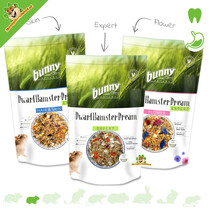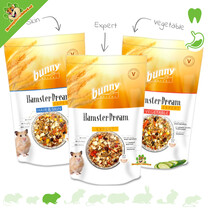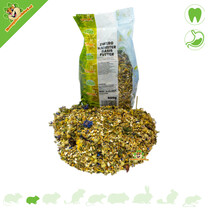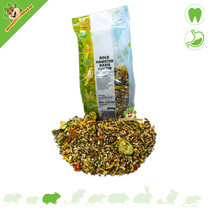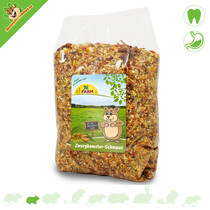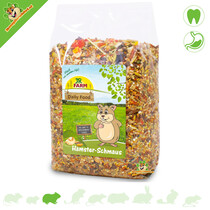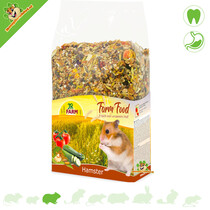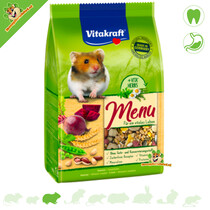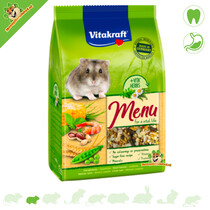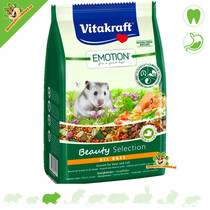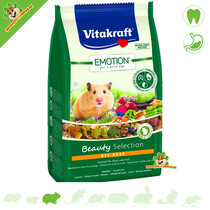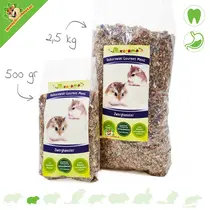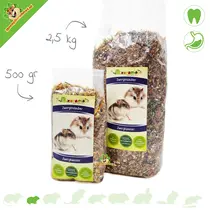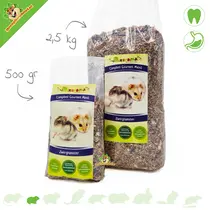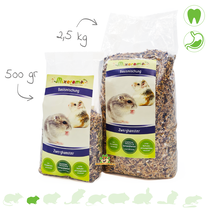Food for Hamsters & Dwarf Hamsters in the Hamster Webshop!
Introducing our specially composed foraging menu, designed with love and care to provide your furry friend with a tasty and balanced meal! Introducing our specially composed foraging menu, designed with love and care to provide your furry friend with a ta
Read moreHamster food from Bunny Nature Dwarf HamsterDroom Expert is a pellet-free complete and natural food for dwarf hamsters such as the Roborovski Dwarf Hamster, Russian Dwarf Hamster, Campbelli Dwarf Hamster and the Chinese Dwarf Hamster. Many hamsters leave
Read moreHamster food from Bunny HamsterDroom Exper is a specialist pellet-free and complete food for hamsters (Syrian Hamster/Golden Hamster). Without extrudates and without pellets. The nutritional needs of hamsters and the latest scientific research were centra
Read moreRodipet Dwarf Hamster Food Variety allows Dwarf Hamsters to enjoy themselves with all their senses! Taste, smell, feel, hear and see. If you look closely at the Dwarf Hamster, you will notice that these little four-legged friends are very happy when they
Read more- Ordered before 5 p.m., shipped the same day!
- Al 14 jaar een begrip!
- Delivery from our own stock
Hamster food for the hybrid dwarf hamster. This mixture is specially tailored to the needs of hybrid dwarf hamsters with an increased risk of diabetes. The unique Rodipet® Hybrid food is the result of the successful Rodenti® expeditions to the land of dwa
Read moreFor our Getzoo Dwarf Hamster Basic Food we have focused on nature's extensive diet. Only seeds and plant parts that occur in the natural environment or resemble the plant world in the steppes have been selected for this Dwarf Hamster food!
Read moreFor our Getzoo golden hamster basic food, we have focused on nature's extensive diet. Only seeds and plant parts that occur in the natural habitat or resemble the plant world in the steppes have been selected for this Golden Hamster food!
Read moreDwarf hamster food from JR Farm Dwarf Hamster Schmaus is a natural complete food that is suitable for all dwarf hamsters, such as the Roborovski Dwarf Hamster, Russian Dwarf Hamster, Campbelli Dwarf Hamster and the Chinese Dwarf Hamster. The versatile pre
Read more- Ordered before 5 p.m., shipped the same day!
- Al 14 jaar een begrip!
- Delivery from our own stock
Hamster food from JR Farm is a natural complete food mix that is suitable for hamsters. Give your hamster a delicious and balanced meal with JR Farm Hamster Schmaus Hamster Food. This carefully formulated mix meets the nutritional needs of hamsters, allow
Read moreDwarf hamster food from JR Farm is a natural hamster food. Give your dwarf hamster a healthy and tasty meal with JR Farm Food Dwarf Hamster Natural Food. This carefully formulated mix meets the nutritional needs of dwarf hamsters so they can thrive optima
Read moreHamster food from JR Farm is a natural food for hamsters. Give your hamster the right nutrition with JR Farm Farm Food Hamster Adult. This carefully formulated mix provides the essential nutrients your hamster needs to stay healthy and active.
Read moreHamster food from Vitakraft Premium Menu vital for hamsters contains valuable grains, tasty seeds and delicious vegetables. It is a balanced mix that hamsters not only like, but with which the hamsters get everything they need for a healthy hamster life.
Read more- Ordered before 5 p.m., shipped the same day!
- Al 14 jaar een begrip!
- Delivery from our own stock
Dwarf hamster food from Vitakraft Menu Vital is the classic among hamster food: the sugar-free recipes from menu vital are the perfect basis for good hamster food that your hamster will enjoy. The dwarf hamster food is tailored to the nutritional needs of
Read moreValuable grains, healthy vegetables and fruity apple; Emotion Beauty Selection All Ages dwarf hamster combines optimal care with a delicious taste and, thanks to valuable oils, also promotes healthy skin and a beautiful, shiny dwarf hamster coat.
Read moreValuable grains, healthy vegetables and fruity apple; Emotion Beauty Selection All Ages hamster combines optimal care with a delicious taste and, thanks to valuable oils, also promotes healthy skin and a beautiful, shiny hamster coat.
Read moreDwarf hamster food from Witte Molen PUUR Mini-Hamster & Friends is a pure & varied gourmet muesli for Dwarf Hamsters (Roborovski Dwarf Hamster, Russian Dwarf Hamster, Campbelli Dwarf Hamster, Chinese Dwarf Hamster), Gerbils (Fat-tailed Gerbils) and Mice.
Read more- Ordered before 5 p.m., shipped the same day!
- Al 14 jaar een begrip!
- Delivery from our own stock
The Dsungaren Menu is a supplementary animal food on a natural basis. This natural food for Russian Dwarf hamsters. The Russian Dwarf Hamster is native to southwestern Siberia and northeastern Kazakhstan. There it feeds its natural environment with small
Read moreWild Roborovski Dwarf Hamsters feed mainly on plant seeds. A smaller part of their food spectrum consists of leaves, stems and insects. This food mixture is a supplementary animal food that is specially tailored to the needs of the Roborovski dwarf hamste
Read moreThe composition of this natural food is based on the nutritional needs of the Syrian golden hamster. The gourmet menu for medium-sized hamsters is a complete animal food and has a high content of starchy seeds and provides the basic supply of animal prote
Read moreThis grain-free Mixerama Natural Food for Campbelli Dwarf Hamsters is a complete diet and is low in carbohydrates. The low-carb recipe relieves the metabolism and therefore this staple food is particularly suitable for dwarf hamsters that already have dia
Read more- Ordered before 5 p.m., shipped the same day!
- Al 14 jaar een begrip!
- Delivery from our own stock
The Mixerama Myps Zwergen Zauber is a complete pet food for Campbellie Dwarf hamsters, Russian Dwarf hamsters and hybrid dwarf hamsters based on many years of experience, knowledge and research by hamster owners. The mixture is also suitable for dwarf ham
Read moreThe Campbell Gourmet Menu is a complete pet food with a varied palette of herbs and seeds that encourages dwarf hamsters to engage with the food for a longer period of time. The composition of the feed mixture is also suitable for hybrids with diabetes pr
Read moreThe Mixerama Fairytale Natural Golden Hamster Food is a complete animal food with a balanced composition of different seeds and herbs that is tailored to the needs of Golden Hamsters. Due to the ideal composition of grains, vegetables, animal proteins and
Read moreThe Mixerama Dwarf Hamster Basic Menu dwarf hamsters (Roborovski Dwarf Hamster, Campbelli Dwarf Hamster, Chinese Dwarf Hamster, Russian Dwarf Hamster) is a complete (animal food) natural food based on the kipi concept. The food has been specially develope
Read moreOrder Hamster Food & Dwarf Hamster Food easily and quickly at DRD Knaagdierwinkel® The online Hamster Webshop for your Hamster!
 For food for your Hamster or Dwarf Hamster you have come to the right place in our Hamster webshop . Here you will find different types and brands of hamster and dwarf hamster food for an attractive price. Little One, Bunny Nature, Witte Molen, Hope Farms, Versele Laga, Beaphar, etc. Ordering is quick and easy in our Hamster webshop.
For food for your Hamster or Dwarf Hamster you have come to the right place in our Hamster webshop . Here you will find different types and brands of hamster and dwarf hamster food for an attractive price. Little One, Bunny Nature, Witte Molen, Hope Farms, Versele Laga, Beaphar, etc. Ordering is quick and easy in our Hamster webshop.
Nutritional needs of the Hamster and the Dwarf Hamster
Hamsters and Dwarf Hamsters are granivores (seed eaters) . The diet of both Hamsters and Dwarf Hamsters consists mainly of seeds and a small amount of vegetable food in the form of herbs , but also animal proteins . Hamsters catch small insects in the wild, so it is good if their diet also contains animal proteins.
The nutritional needs of the different hamster species differ from each other:
Roborovski Dwarf Hamster: Seeds, very little animal food
Russian Dwarf Hamster: seeds, grasses and herbs, insects
Campbelli Dwarf Hamster: seeds, grasses and herbs, insects
Chinese Dwarf Hamster: seeds and no grasses or herbs. The protein content is nil.
Syrian Hamster (Golden Hamster): seeds, grains, insects
Digestive tract of the different hamster species and their differences
1. Roborovski dwarf hamster
The Roborovski dwarf hamster generally has a relatively short intestine and large intestine compared to other hamster species. Because of their dietary preference for seeds and grains, they may have efficient digestion in the small intestine, where nutrients are absorbed. They have a relatively rapid intestinal transit time, which means that food is processed quickly through the digestive tract.
2. Russian dwarf hamster
The Russian dwarf hamster generally has a longer digestive tract compared to other hamster species. They have a relatively larger colon, which may indicate better fermentation of fiber and more efficient digestion of plant matter. Their diet consists of a wide variety of foods, including seeds, grains, vegetables and fruits.
3. Chinese dwarf hamster
The Chinese dwarf hamster has a relatively long and tortuous digestive tract, which can contribute to slow passage of food and efficient digestion. They have a relatively large caecum, a part of the large intestine where fermentation takes place. This may indicate that they are well adapted to a high fiber diet. Their diet consists mainly of seeds, grains, vegetables and insects.
4. Campbelli dwarf hamster
The Campbelli dwarf hamster has similar characteristics to the Russian dwarf hamster. They have a medium length of the digestive tract and an average size of the various digestive organs. They have a similar diet to the Russian dwarf hamster, with a mix of seeds, grains, vegetables and fruits.
5. Syrian hamster
The Syrian hamster generally has a larger digestive tract size compared to the dwarf hamster species. They have a relatively large stomach and intestines, which may indicate better food processing. Their diet consists of a wide variety of foods, including seeds, grains, vegetables, fruits and insects.
Hoarding the Hamster and the Dwarf Hamster
Hamsters & Dwarf Hamsters carry their food in their cheek pouches . What you see is that the hamster stuffs his food into his cheek pouches and quickly takes it to his house or pantry. Carrying food in the cheek pouches is also called 'Hoarding' . Thanks to the cheek pouch muscle, the food is held in the cheek pouch and the Hamster can transport it safely and quickly.
All in one chunk or a mixture?
If your hamster or dwarf hamster really starts to eat selectively , so that he only eats the tasty things, it may be wise to switch to an all-in-one kibble . The hamster can no longer eat selectively in this way. Each piece has its own composition. Hamsters need a few weeks to get used to different food. It is also possible that the hamster will eat less of the all-in-one chunk. This may have to do with the composition of the kibble. Some all-in-one chunks have a very full composition, meaning less needs to be eaten to meet the same nutritional needs.
Is Switching Hamster Food Good?
Hamsters are much less sensitive to a change in food than, for example, a guinea pig or rabbit. Changing food is much easier with these animals. However, we always recommend mixing your own food with the new food for a few days.
Coprophagy in Hamsters and Dwarf Hamsters
Hamsters produce two types of feces: dry, hard feces and soft, nutrient-rich feces called caecotrophs. Caecotrophs are produced in the caecum, a bulge in the large intestine. They contain undigested nutrients, such as fiber and protein.
When hamsters produce caecotrophs, they eat them directly from their anus. The purpose of this is to reabsorb the nutrients that have not been fully digested or absorbed during the first pass through the digestive system. In this way, hamsters maximize nutrient absorption and improve their digestive efficiency.
Coprophagy is a natural behavior in hamsters and plays an important role in their feeding strategy. It allows them to obtain essential nutrients that would otherwise be lost. However, it is important to ensure that hamsters are fed a balanced diet that contains sufficient nutrients so that they are not forced into coprophagy to compensate for deficiencies.
The Teeth of Dwarf Hamsters and Hamsters
Hamsters have specific characteristics when it comes to their teeth.
Incisors: Hamsters have two pairs of incisors at the front of their mouths, an upper pair and a lower pair. These incisors grow continuously throughout their lives. This constant growth process is necessary because the incisors wear out through chewing and gnawing. It helps keep the incisors sharp and prevents overgrowth.
Growth rate: A hamster's incisors grow on average about 2 to 3 millimeters per week. This is why hamsters need constant chewing material to wear down their teeth and control growth.
Chewing and gnawing: Hamsters have a natural need to chew and gnaw. This behavior is essential for maintaining healthy teeth and preventing dental problems. Chewing hard foods and chew toys helps wear down the incisors and stimulates blood flow to the area.
Dental problems: If a hamster's incisors do not wear properly, dental problems can develop, such as overgrowth, crooked teeth or even tooth breakage. These problems can be painful and hinder the hamster's ability to eat. Regular dental checks and provision of sufficient chewing material are important to prevent dental problems.
Diet: A hamster's diet plays an important role in the health of their teeth. Providing nutritious and fiber-rich foods helps in the natural wearing down of teeth. In addition, hamsters should always have access to fresh water to prevent dehydration, which can also affect their dental health.
It is important to check your hamster's teeth regularly for any abnormalities, overgrowth or other problems. If you notice any changes or are concerned about your hamster's dental health, consult a veterinarian with experience with small pets.
The Stomach of Hamsters and Dwarf Hamsters
Hamsters have a unique stomach structure adapted to their diet and digestive needs.
Stomach pouches: Hamsters have two stomach pouches, also known as "fermentation chambers" or "crop pouches". These bags are located at the beginning of the stomach and play a role in the digestion of fiber-rich foods, such as grass and hay. The stomach pouches act as a kind of fermentation chamber where bacteria break down fibers and release nutrients.
Pylorus: The pylorus is the part of the stomach that borders the small intestine. It regulates the passage of food from the stomach to the small intestine. In hamsters, the pylorus is well developed to control the passage of food and optimize digestion.
Stomach acid: Hamsters have relatively low acidity in their stomach compared to some other species. This is because they are mainly herbivores and their diet consists mainly of plant matter. The lower acidity helps digest fiber-rich foods and facilitates the growth of bacteria necessary for the fermentation processes in the stomach pouches.
Capacity: Hamsters' stomachs generally have limited capacity because they are smaller animals. They tend to have smaller stomach sizes in relation to their body size. This means that hamsters can process smaller amounts of food at a time.
The intestines of Hamsters and Dwarf Hamsters
Hamsters have a complex digestive system, including the intestines, that allows them to absorb nutrients from their food.
Small Intestine: The small intestine is responsible for most of the digestion and absorption of nutrients. It consists of three parts: the duodenum, the duodenum and the ileum. These parts release enzymes and other digestive juices to further break down food and absorb nutrients.
Appendix and caecum: Hamsters have an enlarged appendix and caecum, indicating their ability to break down fiber-rich foods such as grass and hay. These parts of the intestine contain bacteria and microorganisms that can break down cellulose and carry out fermentation processes to release nutrients.
Large Intestine: The large intestine follows the small intestine and is responsible for absorbing water and electrolytes from undigested food waste. It also helps form and store stool before it is excreted.
Rectum and anus: The rectum is the last part of the intestinal tract where feces are stored before being excreted. The anus is the end of the digestive system where feces leaves the body.
Can hamsters digest fiber well?
Hamsters have a reasonable ability to digest fiber, but their ability is not as efficient as that of rabbits. Fiber-rich foods, such as hay, vegetables and leafy greens, are important for hamsters' gut health and digestion. It helps promote healthy intestinal flora, stimulates intestinal movement and contributes to good bowel movements.
Although hamsters can digest fiber, they are generally better adapted to a mixed diet that also includes grains, seeds and proteins. They have a shorter gastrointestinal tract compared to rabbits, which means they have less time to fully break down and ferment fiber. Therefore, in addition to fiber-rich foods, it is important to offer other foods that meet their nutritional needs.
Are hamsters granivores?
Granivores are animals that have a diet consisting mainly of seeds and grains. This also applies to many hamster species.
Hamsters have modified teeth and jaws that allow them to crunch and eat seeds and grains. They prefer foods such as sunflower seeds, oats, barley, wheat and other grains. These seeds and grains provide important nutrients, such as carbohydrates, fats and proteins, that are essential for hamsters' health and energy needs.
Although hamsters can also eat other plant materials such as vegetables, fruits and grass, seeds and grains generally make up the bulk of their diet. This makes them mainly granivores.
Are Hamsters Omnivores?
Hamsters can be considered both granivores and omnivores, depending on their specific diet and nutritional preferences. In general, hamsters have a plant-based diet and specialize in eating seeds, grains, and other plant materials. This makes them granivores.
However, some hamster species can also include small amounts of animal protein in their diet. This could, for example, be insects, larvae or small amounts of animal meat. Adding these animal proteins to their diet can serve as supplemental nutrition, but generally does not constitute a large part of their daily diet.
The natural rhythm of food gathering
Hamsters are collectors by nature and only have food available for a short time. In the winter everything starts to become scarce, so they have to do their best to boost food supplies in the summer. The dwarf hamster is therefore always busy looking for and storing food. This behavior is very recognizable for many hamster owners.
The hamster follows its natural rhythm when it comes to collecting food. He doesn't realize that summer and food availability in our home are endless. He happily continues collecting and if you let him do his thing, a large stock is built up.
High-energy food first
Life is hard in the wild, those who have not collected enough will not survive. Anyone who does not have enough fat reserves will feel cold and difficult. This is the main reason why hamsters eat energy-dense food first. Their instincts compel them to do this. Energy-rich food provides energy and makes it possible to build a fat layer. The latter helps against cold and provides a buffer in case you have trouble finding food. They simply do not know that the animals do not have to be afraid of this in our home and that is why they continue to eat the energy-rich food first.
By energy-rich food we mean food with a higher content of: (natural) sugars, carbohydrates/starch and fats. The animals will therefore eat sweets (sugars/carbohydrates) first, followed by fruit (natural sugars), pea flakes (starch) and sunflower seeds (fats). We also call this preference selective eating .
Important: Carbohydrates, sugars and fats are indispensable for dwarf hamsters. They need these nutrients in large quantities to meet their energetic existence. Too much of these nutrients is not good, but too little is just as bad!
This is how we prevent selective eating!
Be strict!
There is actually one good way to avoid selective eating and that is to be strict . The animals should be given the prescribed portion of food and only given a new portion once the old one has been eaten. In this way, selective eating is no longer possible. However, many owners find it difficult to be so strict with their darling.
If you suddenly decide to be strict with feeding, you may notice that your hamster will eat less. This is a natural reaction of the animal. His food supply becomes smaller, creating a feeling of scarcity. He has to eat less now or he won't make it through the winter (he thinks). The owner is shocked by this, my animal suddenly eats less and probably also loses weight. These are signals that we don't like to see!
Adjust nutrition
It can help to switch to a food with a different composition or to remove the tasty things that the hamster takes from the food and only give it when the other things have been eaten.
Everything in one chunk
A last resort is the all-in-one kibble. These chunks are all the same, which means no selective eating behavior can occur and therefore no nutritional deficiencies. The all-in-one chunk does not entirely fit into the natural diet menu. The animals therefore need a longer adjustment period, but once they get used to all-in-one chunks, they eat it very well and remain stable in terms of condition and weight.
For rabbits and guinea pigs, the all-in-one kibble is already well established and is one of the primary feeding methods. The animals are in better condition if they are fed all-in-one chunks.
For an owner who wants to be 100% sure that his animal always receives all the nutrients, the all-in-one chunk is a solution.
It remains an art to keep the hamster's eating habits in balance. Due to its collecting and therefore hiding behavior, it is sometimes quite a challenge to find all the food supplies. If your hamster eats selectively, but otherwise looks good, there is no reason to panic. Some animals seem to eat selectively, but secretly balance their diet in a good way. These animals have a good weight, beautiful coat and sparkling eyes.




